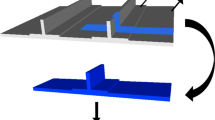Abstract
Mass sweeping and current efficiency factors (f m and f i ) are two important parameters in Z-pinch devices, because one can compute those to better analyze Z-pinch dynamics. In this paper, the advanced shock model was employed to calculate and compare the aforementioned parameters for ACOL Z-pinch in three different working regimes. It was found that f m is in the range of 0.12–0.13 for hydrogen gas at p 0 = 400 and 800 Pa pressures and f m = 0.13 for helium gas at p 0 = 260 Pa. Similar works have resulted f m in the range 0.10–0.16. Therefore our computations of f m values (range 0.1–0.13) agree with the f m range, and it confirms our model. Therefore, the factors can be precisely being calculated using advanced shock model for various Z-pinch systems at different working regimes.








Similar content being viewed by others
References
M.J. Sadowski, M. Scholz, Important issues in high-current plasma experiments of the Z-pinch type. Nukleonika 57, 11–24 (2012)
M.A. Liberman, Physics of High Density Z-Pinch Plasma (Springer, New York, 1998)
S. Lee, S.H. Saw, Numerical experiments providing new insights into plasma focus fusion devices. Energies 3, 711–737 (2010)
S.H. Saw, S. Lee, Scaling laws for plasma focus machines from numerical experiment. Energ. Power Eng. 2, 65–72 (2007)
H. Sze, Magnetic Rayleigh–Taylor instability mitigation and efficient radiation production in gas puff Z-pinch implosions. Phys. Plasma 14, (2007)
M. Manuel, Mapping return currents in laser-generated Z-pinch plasmas. APL (2012)
S. Goudarzi, A. Raeisdana, Computation of mass sweeping efficiency factor and current efficiency factor in Z-pinch devices. J. Fusion Energ. 30, 130–132 (2011)
D. Potter, The formation of high density z-pinches. Nucl. Fusion 18, 813 (1978)
E.P. Boggasch, J. Christiansen, K. Frank, R. Tkotz, H. Riege, Z-pinch current enhancement by the inverse skin effect. IEEE Trans. Plasma Sci. 19, 866–871 (1991)
T.D. Mahabadi, M.A. Tafreshi, An investigation of the plasma behaviour in a Filippov type plasma focus device. Plasma Phys. Control. Fusion 49, 1447–1455 (2007)
J.H. González et al., A lumped parameter model of plasma focus. IEEE Trans. Plasma Sci. 32, 1383–1391 (2004)
M. Niknam, S. Goudarzi, A. Raeisdana, M. Jafarabadi, Numerical analysis of amirkabir plasma focus (APF) device for neon and argon gases. J. Fusion Energ. 32, 258–262 (2013)
S. Goudarzi, R. Amrollahi, R. Saberimoghaddam, A model based on lumped parameters for Filippov-type plasma focus devices. J. Fusion Energ. 27, 195–199 (2008)
Author information
Authors and Affiliations
Corresponding author
Rights and permissions
About this article
Cite this article
Raeisdana, A., Sadat Kiai, S.M., Sadighzadeh, A. et al. Numerical Study of Z-pinch Dynamics at Different Working Regimes. J Fusion Energ 33, 746–751 (2014). https://doi.org/10.1007/s10894-014-9740-3
Published:
Issue Date:
DOI: https://doi.org/10.1007/s10894-014-9740-3




